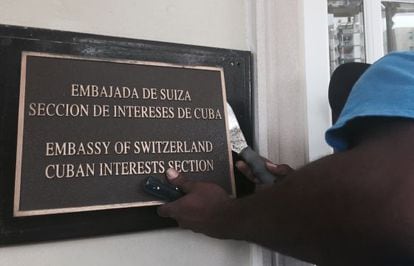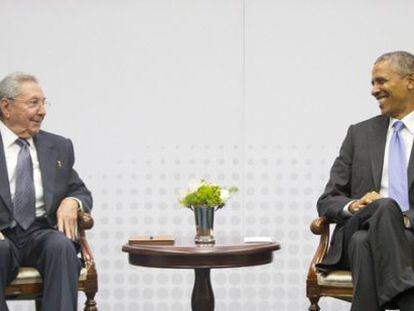US and Cuba reopen embassies after 54 years with no diplomatic ties
Washington and Havana take the first big step toward normalizing bilateral relations

The definitive breaking of diplomatic relations between the United States and Cuba, and the closing of their respective embassies, came on January 3, 1961. It was ordered by then-US President Dwight D. Eisenhower.
But the Republican leader, who was just weeks from handing over the White House to John F. Kennedy, held out hope that one day, bilateral relations would be restored.
The reopening of the embassies is the most symbolic gesture coming out of intense negotiations
“It is my hope and my conviction that in the not too distant future it will be possible for the historic friendship between us once again to find its reflection in normal relations of every sort. Meanwhile, our sympathy goes out to the people of Cuba now suffering under the yoke of a dictator,” he said in a statement at the time.
But it would not be until just after midnight on July 20, 2015, that Washington and Havana took a major step toward patching up those ties, and reopened their respective embassies.
Eleven US presidents have come and gone but only two Cuban leaders – Fidel Castro and his brother Raúl – have been in power during the 54 years and six months since that day when Eisenhower expressed his hopes that relations would be reestablished.
The reopening of the embassies is the most symbolic gesture to have come out of six months of intense negotiations aimed at restoring full diplomatic ties between the United States and Cuba, as was announced on December 17 by Barack Obama and Raúl Castro.
There is a still a long and difficult process ahead, as both sides have acknowledged, before a long list of grievances and concerns Washington and Havana have can be dealt with.
The United States is still concerned about human-rights issues on the Caribbean island, while Cuba is demanding that Congress lift the US trade embargo.
But then, it has been a tortuous process for US and Cuban diplomats to get where they are now.
The original break in relations between the two countries was a long time coming. After Fidel Castro came to power in 1959, he demanded that the US Embassy reduce staff at the mission to 11 – the same number Cuba had in Washington.
In an urgent telegram sent to his superiors, then-US Charge d’Affaires Daniel Braddock said that Castro was claiming that “90 percent of the embassy personnel were actually spies.”
In his opinion, Braddock said that the embassy could not function well with such a small staff and recommended a break in diplomatic relations, which Eisenhower eventually approved.
The number of diplomats assigned to each embassy and their duties continued to be a thorny issue when it came to negotiations between Obama and Castro officials..
Under President Jimmy Carter, the State Department opened a US Interests Section, which operated under the legal protection of the Swiss government. With more than 400 employees, including 50 US diplomats, it is considered the largest diplomatic presence in Cuba, according to a 2014 State Department report.
At the Cuban mission in Washington, the number of staff is barely a dozen.
The US charge d’affaires said that Castro was claiming that “90% of the embassy personnel were actually spies”
After four rounds of high-level negotiations, which had been held in both capitals since January, an agreement was reached that was “acceptable” to Washington.
The United States had insisted that its diplomats would be allowed to move freely outside Havana to speak with residents in other cities without having to ask for special permission from the Cuban authorities.
Under US policy, Cuban officials need permission to travel beyond Washington.
Both sides finally agreed that diplomats will only have to “notify” officials in the host countries about their movements – a decision Washington says it can live with because it is similar to other policies in nations with which the United States has rocky relations, but in which it still maintains a diplomatic presence.
While the US Interest Section in Havana will function as an official embassy from Monday, a flag-raising ceremony won’t be held until next month when US Secretary of State John Kerry is expected to travel to Havana, the Associated Press reported.
But later on Monday, Cuban Foreign Minister Bruno Rodríguez will hold an official ceremony in Washington for the reopening of the embassy, to which 500 guests have been invited. He will also meet with Kerry for private talks.
The event will mark the first time that a Cuban foreign minister has visited Washington since 1959.
English version by Martin Delfín.











































